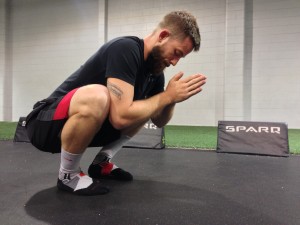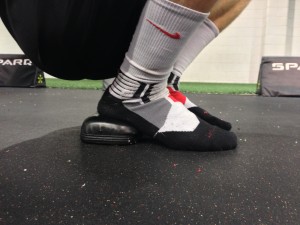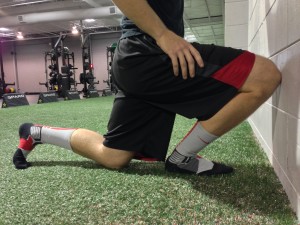Basketball Players and Poor Ankle Mobility
 By: Adam Tindal, CSCS, NASM-PES
By: Adam Tindal, CSCS, NASM-PESPerformance Specialist
SPECTRUM, Inc
To all my hoopers and shot blockers out there, the ankle is naturally meant to be a mobile joint. Therefore, when we wear braces or flashy high top shoes, we are essentially lighting the fuse to a time bomb waiting to blow off on our heel cords. The purpose of this article is to give all basketball players out there, from point guards to centers, a different perspective on performance over style. It comes as no surprise that many young ball players want to wear the newest gear and tape their ankles up like they’re Brooke Lopez, that is until they end up with shin splints, knee pain, or any other injury that may occur from the ankles.
In the sport of basketball it is common for a player to spend hours on the court, practicing and playing without a single thought going to taking care of his or her body. A major meltdown may occur if I continue hearing the same responses in regards to mobility and flexibility training, “I can do that at home” or “I don’t need to worry about that right now.” These are some of the more common excuses I hear from many basketball players who are simply eager to toss weight around and blindly run their bodies into the ground. I don’t always like doing it, you don’t always like doing it. However, often as it may be disregarded, soft tissue work plays a vital role in our ability to resolve pain and prevent injury. When we fail to make these undeniably laborious tasks a top priority, we begin to deprive our bodies of the opportunity to not only maximize performance, but also ensure us the longevity we all desire.
Ankles locked up tighter than Alcatraz, as seen in many basketball players, will command the majority of our focus here and now. We must come to understand that poor range of motion at the ankle joint can have devastating effects on the rest of the body. Seeking out a professional assessment to determine where you are at and what needs to do be done is always ideal.
When we see the feet spin outward in the squat pattern it becomes evident that something sinister lurks within. It should also be noted that this common tell could also be a result of poor internal rotation at the hip. However, the ankle is typically the culprit. As the spin of the foot begins, it increases the risk of forcing the knee inward, thus, throwing off our line of gravity and raining down a Godly firestorm of unwanted sheer forces onto our knees. Poor movement patterns such as this may not seem like such a huge deal at first, but over time it exponentially increases our risk of serious injury. For an athletic shooting guard, who is constantly coming off of screens to catch and shoot over and over, this could be detrimental. Once the player pulls up for a jump shot, the knees will be forced to rotate internally to compensate for the tight ankles. If not corrected, this faulty movement pattern could eventually give out. Though injury may not occur during a jump shot, it is possible that a sharp cut or unexpected landing could play the role of the grim reaper.
Additionally, compensations occur throughout the body due to poor ankle mobility. One such being the propulsion of the body off of the front side of the foot and the toes. Inhibited dorsiflexion, think of how far the knee can move past the toes, can force us to front load the body and primarily rely on the anterior musculature to launch us into action. In reality, we should be recruiting far more support from the posterior chain to help us produce the required force we are looking for. If you can picture a power forward constantly boxing out in the post and battling for rebound after rebound, the continuous reliance on the quads to jump could tip the first domino in a long line of potential injuries and imbalances that will put the body at risk in the future.
We can apply soft tissue work to the calf muscles and our heel cords to help loosen some of the surrounding muscles or any scar tissue that may be hindering us. Using a lacrosse ball on the foot to trigger point the musculature within the arch can prove to be effective as well. Often times, the simplest of tricks can help save us from more complex and time consuming methods.
 A couple of my favorites are working into a deep squat hold and basically hanging out for an allotted period of time.
A couple of my favorites are working into a deep squat hold and basically hanging out for an allotted period of time.  Those with exceptionally tight ankles may want to elevate the heels on bumper plates or any available wedge.
Those with exceptionally tight ankles may want to elevate the heels on bumper plates or any available wedge.  We can also use a simple technique that has us kneeling in front of a wall and lining our foot up about 5-6 inches away. Then try to touch the front knee to the wall without removing the heel from the floor. This is a great way to stretch that heel cord and posterior portion of the foot and ankle and improve dorsiflexion.
We can also use a simple technique that has us kneeling in front of a wall and lining our foot up about 5-6 inches away. Then try to touch the front knee to the wall without removing the heel from the floor. This is a great way to stretch that heel cord and posterior portion of the foot and ankle and improve dorsiflexion.
Leave a Reply